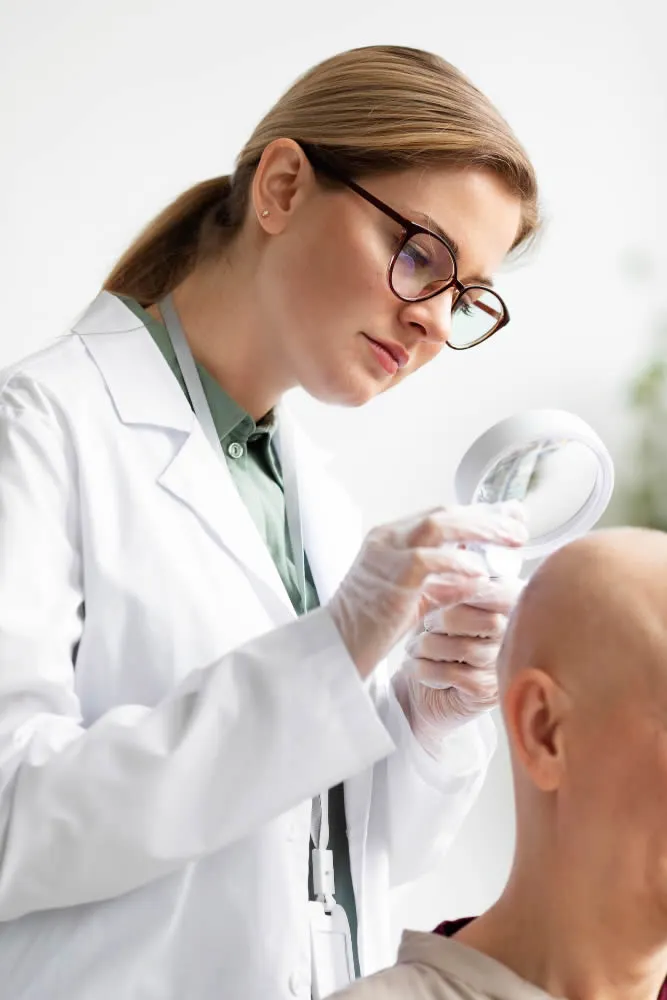What is Microcystic Adnexal Carcinoma?
Microcystic Adnexal Carcinoma is a rare cancer caused by an abnormal growth that starts in sweat glands. This condition typically shows up on the head and neck, especially in the middle part of the face. Sometimes it can appear in other places like the armpits, chest, private parts, and arms or legs, but this is pretty unusual. It looks like a scar but can be found on skin that’s been exposed to the sun.
The surprising thing is that this cancer doesn’t often spread to other parts of the body, which is good news. It’s rare by itself, and it can even get into bones, blood vessels, cartilage, muscles, and nerves. Even though it doesn’t usually spread, there’s still a risk that it might come back after treatment.
This cancer tends to follow along nerves in the body. It mostly affects older people. In rare cases it can affect kids.

Symptoms of Microcystic Adnexal Carcinoma
Skin Lesions: MAC typically presents as small, firm, skin-colored or pinkish lesions on the skin. They may resemble scars or small bumps. These lesions tend to grow slowly over time.
Slow-Growing Tumors: The tumors associated with MAC are generally slow-growing and painless, which means they may not cause discomfort in the early stages.
Infiltrative Nature: One characteristic of MAC is its infiltrative nature, which means it can spread along nerves, leading to numbness or tingling sensations in the affected area. This is known as perineural invasion.
Location: MAC often occurs on the head and neck, particularly in the central facial area. It can also appear in other areas of the body, although this is less common. The lesions are often found on sun-exposed skin.
Size and Shape: MAC lesions can vary in size but are generally small. They may be round or irregular in shape.
Absence of Symptoms: In some cases, MAC may not produce any noticeable symptoms, especially in its early stages. It may only be discovered during a routine skin examination.
Ulceration: In advanced stages, MAC lesions may become ulcerated or develop crusts.
Diagnosis of Microcystic Adnexal Carcinoma
- Biopsy: A crucial starting point, a biopsy involves the careful extraction of a small tissue sample from the affected area.
- Microscopic Analysis: The extracted tissue undergoes rigorous microscopic testing. Skilled pathologists examine the cellular structure, looking for specific features indicative of MAC. This detailed analysis helps differentiate MAC from other conditions and confirms its presence.
- Imaging Tests (Ultrasound and MRI): Ultrasound and MRI scans can also be used.
Treatment of Microcystic Adnexal Carcinoma
When addressing Microcystic Adnexal Carcinoma (MAC), a range of treatments is available, each tailored to the individual’s circumstances. These treatments encompass surgical interventions and therapeutic measures, with a focus on providing effective and personalized care:
- Surgical Options: Small incisions and Mohs microsurgery serve as the cornerstones of surgical intervention. The distinctive advantage of Mohs micrographic surgery lies in its precision – it determines margins meticulously, reducing the need for repeated procedures and subsequent visits. In cases where Mohs micrographic surgery isn’t feasible, the surgical approach is guided by intraoperative frozen sections, ensuring accurate removal.
- Follow-Up Care: Post-treatment, a critical aspect of MAC management, involves consistent follow-up visits. Patients are advised to consult their healthcare provider every six to twelve months.
- Addressing Lymph Node Metastasis: In severe cases of lymph node metastasis, surgical excision of affected lymph nodes may becomes necessary.
- Chemotherapy Consideration: Chemotherapy may be used in conjunction with other therapies.

FAQ about Microcystic Carcinoma
Is MAC contagious?
No, Microcystic Adnexal Carcinoma is not contagious. It is a type of skin cancer that develops internally and cannot be spread through contact.
Can MAC affect children?
While Microcystic Adnexal Carcinoma is more commonly observed in older individuals, it can occasionally affect children. However, this is quite rare.
What are the long-term effects of MAC treatment?
The long-term effects of MAC treatment can vary depending on the individual and the treatment methods used. Surgical procedures may leave scars, and chemotherapy might have side effects. Consulting with a healthcare professional can provide a clearer understanding of potential outcomes.
Is there a dermatologist near me in Fort Worth that offers treatment for Microcystic Adnexal Carcinoma ?
Yes. At our Fort Worth dermatology office, we offer treatment for Microcystic Adnexal Carcinoma to patients from Fort Worth and the surrounding area. Contact our office today to schedule an appointment.

